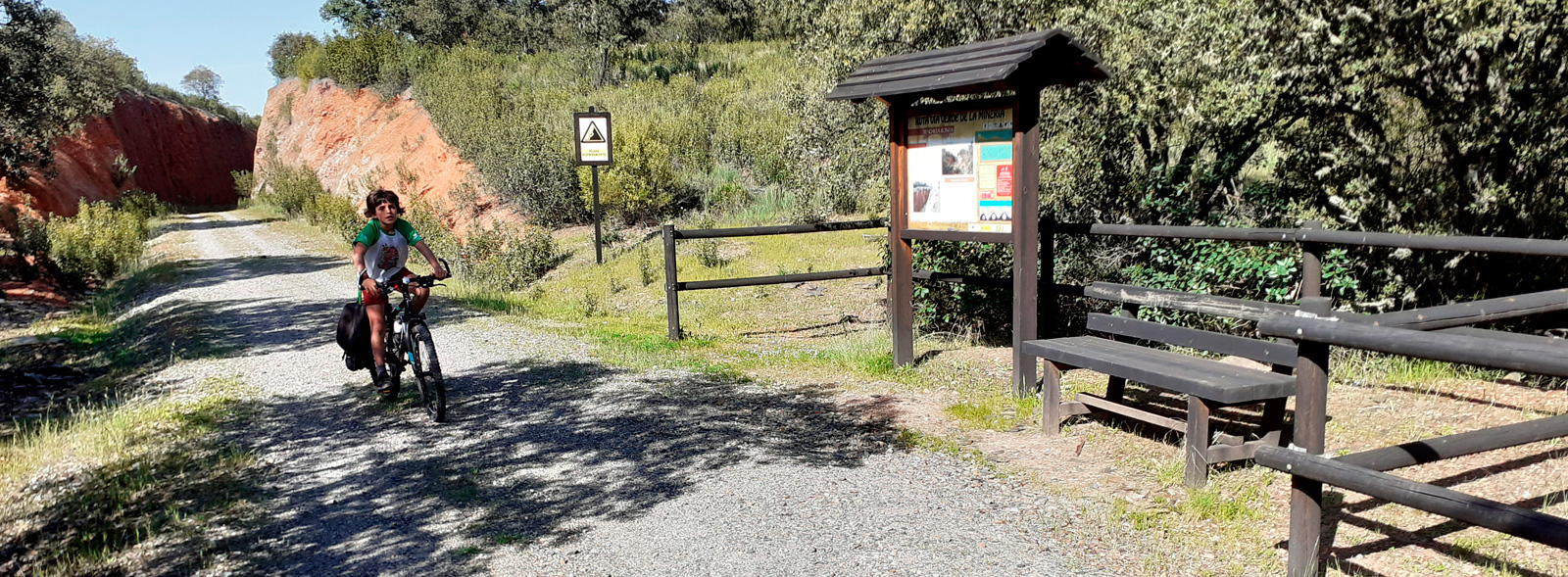Guadiato and Los Pedroches Greenway
Route Description
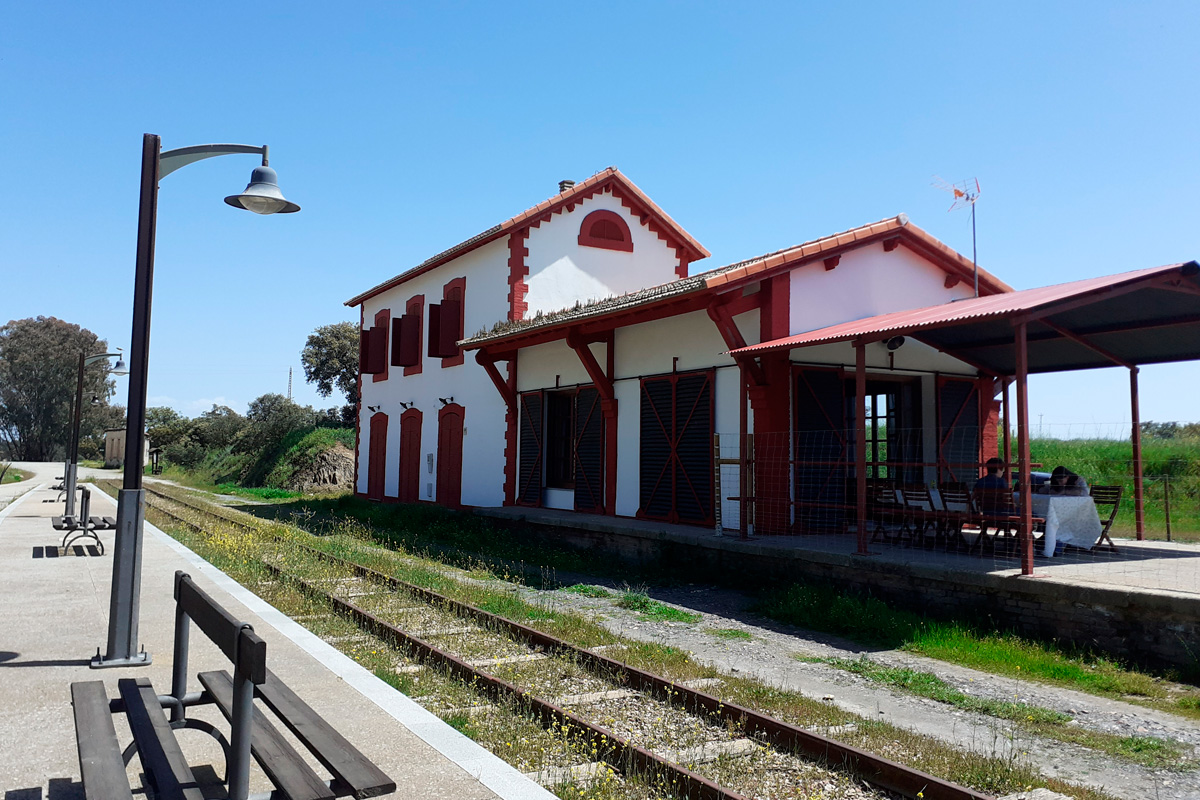 This Cordoba greenway resulted from the unification of several restored sections of the Fuente del Arco-Peñarroya-Puertollano railway, which were independent greenways until 2020, when they began to be linked together. Even so, it is worth mentioning that the signage and nomenclature of the different sections still exists (La Maquinilla Greenway and La Minería Greenway).
This Cordoba greenway resulted from the unification of several restored sections of the Fuente del Arco-Peñarroya-Puertollano railway, which were independent greenways until 2020, when they began to be linked together. Even so, it is worth mentioning that the signage and nomenclature of the different sections still exists (La Maquinilla Greenway and La Minería Greenway).
To date (mid-2023), some sections are still being built (between km 17 and km 25). If construction work is still underway when you arrive, we recommend taking the alternative route of the A-3175 regional road and a public road that has been made through the impressive public area of Cámaras Altas.
Other sections offer alternative routes (between km 4.8 and km 15) in the connection between Fuente Obejuna and Peñarroya. If this is still the case, we recommend taking the Barrero road as far as El Porvenir de la Industria, and from there to Peñarroya via the road leading to Tierno Galván Street.
Fuente Obejuna and connecting route
The route begins approximately 1.5 km from the road between Fuente Obejuna and Los Blázquez, and continues across the San Pedro stream; here, the wooden bridge over the watercourse stands out. After crossing the road towards La Granjuela, we arrive at the Fuente Obejuna aerodrome. We will have travelled for 4.8 km along the greenway.
The next section, of just over 10 km, is still not finished, so to connect with the Guadiato and Los Pedroches Greenway ("La Maquinilla" section) we will have to take the Camino de Los Riscos route until we reach Porvenir de la Industria, where, via Camino del Palenciano and the road from La Granjuela to Peñarroya, we can reach El Cerco de Peñarroya.
It is worth knowing that this connecting route involves some difficulty and is not signposted. We recommend checking the map for details about the track.
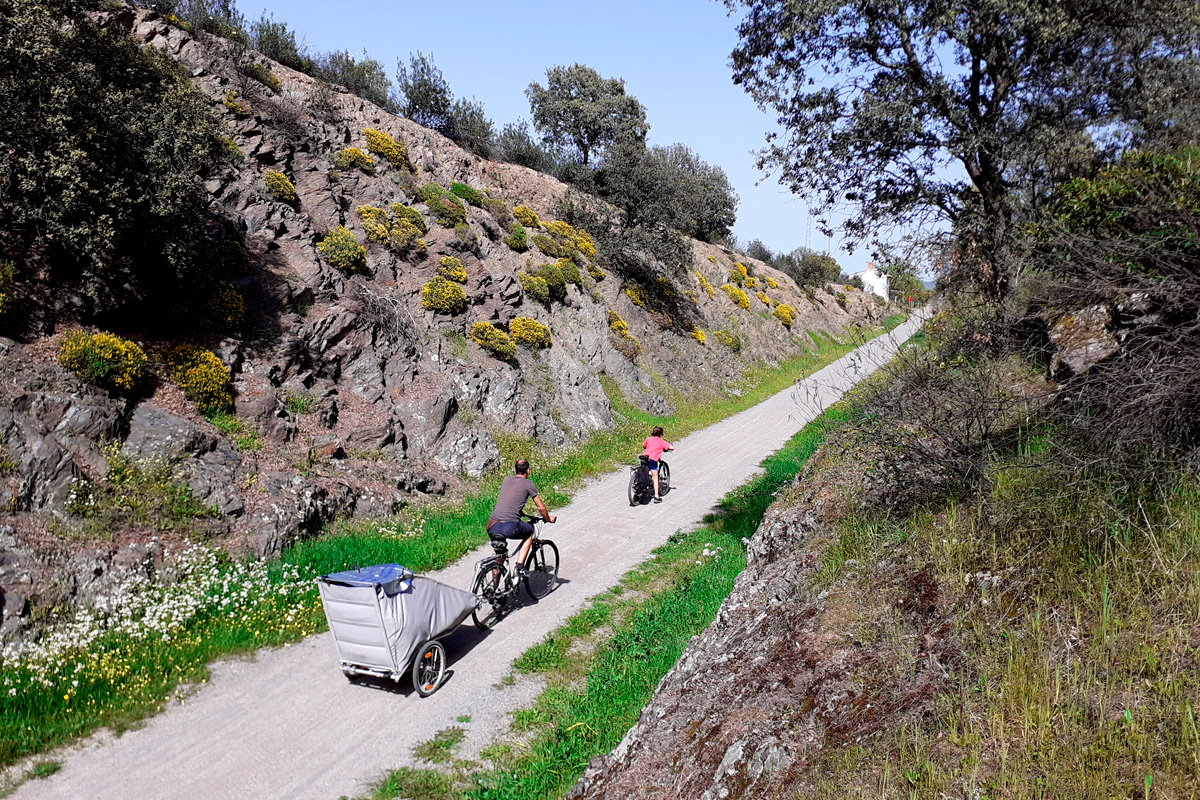 Peñarroya – Pueblonuevo, the La Maquinilla Greenway
Peñarroya – Pueblonuevo, the La Maquinilla Greenway
The route continues at the central warehouse of Cerco Industrial de Peñarroya-Pueblonuevo, an industrial cathedral featuring Eiffel-like architecture. It houses a railway museum where you can admire some of the locomotives that travelled along this valley's railway lines, hauling minerals and products made in this immense industrial area called Cerco. Opposite the central warehouse, beside the bus station, all types of services are available to visitors (restaurants, shops and accommodation).
From the central warehouse, there are two options for undertaking the route: the first, following a circular itinerary inside the Cerco industrial area, entering and exiting at the same point, travelling along the railway sections that have been restored as a greenway, or beginning the route towards Villanueva del Duque —without passing through the Cerco area— crossing the road in the Station neighbourhood and following the kilometre signs that, although they are in the reverse order, indicate the way, since they belong to the signs of La Maquinilla Greenway; its km 0 was established in the locality of Belmez, in harmony with the history of this broad-gauge railway line, before it was integrated into the Guadiato and Los Pedroches Greenway.
It is worth noting that the former Pueblonuevo Station and the Guadiato and Los Pedroches Greenway Interpretation Centre have been restored; this is the first greenway interpretation centre in the province of Cordoba.
Following this reverse-order signposting, 1 km to the right we come across the remains of Mine No. 4, which stands out in the landscape due to its yellow, cylindrical housing. This hard coal mine was opened in the early 20th century and closed in 1973. It is sadly renowned as the site of a serious accident in the 1960s, in which 4 miners died.
After turning right, there appears in front of us a green space made up of wetland. These are opencast mines that have been restored as a peri-urban park. It is also a good place as the beginning of the route with rest areas and parking for vehicles.
Further on, there is another drop on the left, which leads to a gallery of elm trees. On coming out of this tree-lined "tunnel," we come across a reddish, almost Martian-like terrain, which is full of large rocks. These are the result of the atmospheric reaction of the coal burned in the Cerco power station, which, while still incandescent, was hauled to this area by rail. Erosion did the rest, giving rise to this special landscape.
We leave the Peñarroya-Pueblonuevo Railway behind, peddling along a 500-metre cycle lane. At the end of this section, on the left, we come across the slag heap of Antolín Mine, which was the coalfield's most productive one.
The cycle lane links up with a well-compacted trail surrounded by fields of cereal, wooded meadows and more mine shafts, such as that of Las Palomas, right beside us on the left.
Belmez and its castle
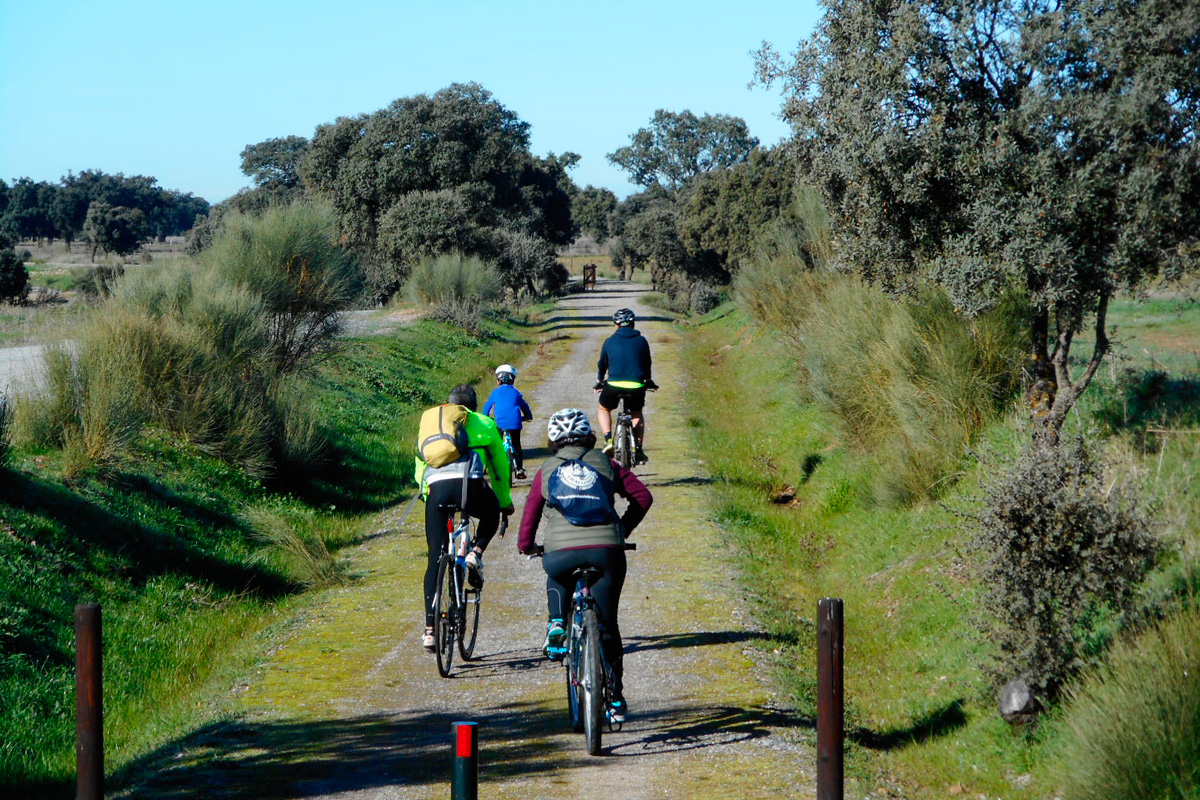 The impressive silhouette of the rocky hill crowned by Belmez Castle accompanies visitors. It is a military watchtower built by the Moors, which formed part of a complex of forts.
The impressive silhouette of the rocky hill crowned by Belmez Castle accompanies visitors. It is a military watchtower built by the Moors, which formed part of a complex of forts.
Through wooded pastureland and crops, this section is especially beautiful and should be savoured slowly.
In Belmez, there is a rest area and a picturesque, white-and-red building. It is the station of Belmez-Ermita, which formed part of the old Peñarroya-Puertollano narrow-gauge line. It has now been converted into a restaurant with a municipal swimming pool –a good place for getting provisions. From here it is also very close to the centre of the town, which makes it a good opportunity for a visit.
The cycle lane that runs alongside the station leads to a road (A-3175) next to the Chapel of Nuestra Señora de los Remedios. We should take it, turning left. We will continue for 300 m and then pass over the N-432 road. Immediately thereafter, we take a trail that appears on the left. This links up again with the railway line.
Another possibility is to go for a few meters along the N-432 towards Peñarroya. As soon as we pass the bridge over the A-3175 road, the railway line will appear on the right.
Guadiato Greenway
The first 500 metres of shared traffic with agricultural vehicles has not been upgraded and has a fairly irregular surface. We just have to be patient for a little while because we quickly reach the section signposted as "Vía Verde del Guadiato" (Guadiato Greenway), which has recently been upgraded by Cordoba Provincial Council.
From this point on, the horizon turns into the Mediterranean forest's unmistakable green colour, featuring holm oaks and gall-oaks along a 5-km stretch, as well as rockroses, thyme and rosemary.
The Aguas Vivas Centre, which is located here, is another interesting tourist facility. It offers horse-riding routes and other options. The section combines deep trenches and open spaces that enable us to make out, on the right, the large fang-like rock called Peña Ladrones, which is home to the largest colony of Griffon vultures in the province of Cordoba. It used to be a refuge for bandits, and for Republican and pro-Franco soldiers.
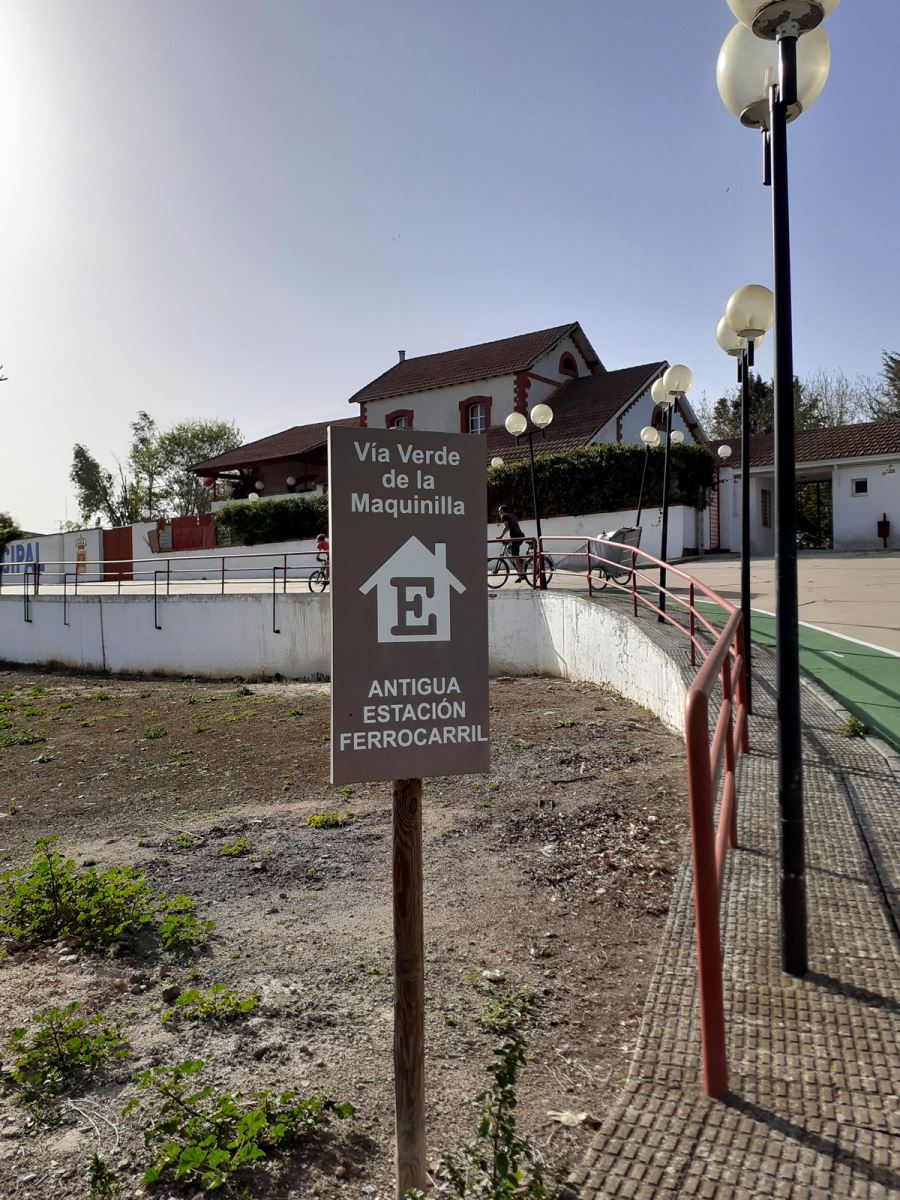 At the moment, the greenway's route is interrupted due to restoration work being carried out at km 32, beside the bridge over the Risquillo stream. Thus, for the moment we travel along a path for a few metres until we take the A-3175 road towards Villanueva del Duque. Once there, we go along the asphalt for 4 km until we see the station of Cámaras Altas.
At the moment, the greenway's route is interrupted due to restoration work being carried out at km 32, beside the bridge over the Risquillo stream. Thus, for the moment we travel along a path for a few metres until we take the A-3175 road towards Villanueva del Duque. Once there, we go along the asphalt for 4 km until we see the station of Cámaras Altas.
From here there begins a compacted trail that we have to take as an alternative to the current roadworks being carried out by the Ministry of Agriculture, Fisheries and Food. This trail goes through an area of great ecological value made up of conifers. It is a singular spot due to fortified constructions from the Spanish Civil War, the fact that saffron milk caps grow here, and finally, the presence of boars and deer.
Although the trail continues, 4 km from the previous one, we take a stony turnoff on the left that goes up to a signalman's hut. We should follow the original route for 300 m (unrestored as of yet!!) as far as the "old" La Minería Greenway, which we will not leave until the end of our trip.
Towards Minas del Soldado
There will be 5 km of a delightful mountain itinerary through trenches of different sizes (it is worth noting the one called "Trinchera bonita") that alternate with masses of rockrose, holm oaks, cork oaks, gall oaks and eucalyptus.
You can also see the signal boxes belonging to the company called Sociedad Minera y Metalúrgica de Peñarroya (SMMP).
Other characteristic elements of this railway line are the water wells that the SMMP, in an attempt at improving the workers' spartan living conditions, ordered to be built beside the huts, as well as a pen that could have been used as a vegetable garden or stable for cattle. These are now highly photogenic, ethnographic elements of the greenway.
Km 45 of the route takes us to the station of Peñas Blancas (1906), which has recently been restored and will soon house new services. At the moment, there is a very pleasant rest area.
From here on, we continue our journey bordered by young holm oaks. Along the way, we can see extensive pig farms where the animals roam freely, being raised to produce ham belonging to Los Pedroches Designation of Origin (D.O.), considered one of the best in Spain.
It should be noted that this last section has some points and trenches that have not been upgraded for the greenway that –although delightful and signposted– go outside the original route of the railway. That means that there will be some slopes and descents that will have to be faced with strong legs and enthusiasm.
Our route ends at the station of another mining operation: Minas del Soldado. These masses rise up to a height of 4 stories and cover an area equivalent to several football fields, which shows us that this was no ordinary mining operation. It is possible to visit the mining enclosure while exercising care. Among the remains, we can identify the engineers' houses and a power station that provided energy for the mines' extraction equipment.
The finishing touch is Minas del Soldado Station, whose main building and the signal box have been restored as charming rural accommodation where you can play for a few days at being the station master. New projects underway promise to expand the greenway towards Hinojosa... we will let you know when it happens.
